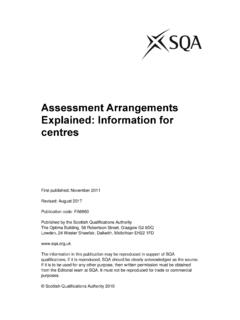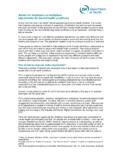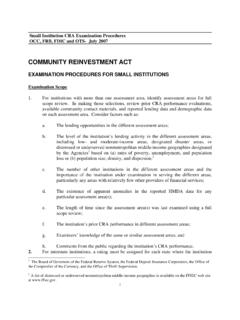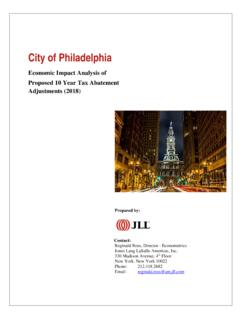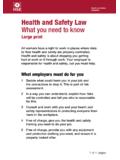Transcription of Health and safety for disabled people and their employers ...
1 Page 1 Health and safety for disabled people and their employersPage 2 ContentsHealth and safety for disabled people 3 Guidance for employers 3 Guidance for employees 6 The law 8 Frequently asked questions 11 Myths 15 Practical examples 17 Further examples 19 Resources and useful links 19 Page 3 Health and safety for disabled peopleHealth and safety legislation should not prevent disabled people finding or staying in employment and should not be used as a false excuse to justify discriminating against disabled want to enable disabled people and those with Health conditions, including mental Health conditions, to get into and stay in guidance will help those employing disabled people to understand their Health and safety for employersAs an employer you are responsible for the Health , safety and welfare of all your employees, whether they have a disability or not. You cannot always tell when someone has a disability and some people may not make you aware that they are disabled , particularly where it will not interfere with their ability to do the job.
2 You have a duty to consult with your employees, or their representatives, on issues relating to Health and safety . They know about the job and how the way it is done can impact upon them, and they are likely to have good ideas about how to change things to make the situation better. Risk assessmentThere is no requirement to carry out a specific, separate, risk assessment for a disabled person. If you become aware of a worker (or others, visitors) with a disability, you may need to review your existing risk assessment to make sure it covers risks that might be present for 4 Don t make assumptions or introduce blanket policies, be aware that disabilities can affect people in very individual ways. Unnecessary assumptions might include: Thinking a driver who loses an arm can t drive anymore - steering wheels can be modified or replaced, with a joystick; Believing a deaf person can t be warned of fire - flashing lights can supplement sirens and bells; Thinking a person with a mental Health condition cannot do a demanding job they can, as long as the risks are managed and they are supported in their role, so that it does not become stressful; Employing someone with a disability is going to be expensive many reasonable adjustments required by equality law, do not incur costs (see reasonable adjustments below).
3 Unnecessary blanket policies might include: Banning all people with a certain condition from carrying out particular tasks, despite the fact that symptoms and severity of symptoms for that condition differ greatly from person to person. Instead, consider how the condition actually affects their ability to carry out the task. Reasonable adjustmentsUnder equality law, you have a duty to make reasonable adjustments for disabled workers. The aim of the duty is to make sure that, as far as is reasonable, a disabled worker has the same access to everything that is involved in doing and keeping a job as a non- disabled 5 This may mean removal of physical barriers and/or providing extra support for a disabled worker. In many cases, making adjustments will be simple and low cost, and an employer is not required to do more than is reasonable; for example improving access or layout, adapting work equipment or relocating a workstation. What is reasonable will depend, among other things, on the size and nature of the business.
4 If the support needed is subject to delay, it might be necessary to implement short-term temporary arrangements for disabled workers. In addition to discussing things with your disabled workers, you may need to involve others to help understand the effects on workplace Health and safety of your employee s disability. For example disability employment advisors or medical professionals. Remember, you cannot insist employees reveal details of their disability, they are under no obligation to do so, and you must get their consent before approaching specialists or doctors. Ensure the disabled worker is involved in this process and share with them any specialist information provided. people with mental Health conditions, including those linked to stress, may also require adjustments in the workplace, with employees and employers working 6 Guidance for employeesAs an employee, you should: Take reasonable care of your own Health and safety and the Health and safety of anyone who might be affected by what you are doing; Co-operate with your employer on Health and safety issues.
5 This includes listening, following instructions and training, and using any safety equipment that has been provided; Inform your employer or manager if you see something that might harm you or someone do not have to disclose your disability. However when making this decision, you will want to consider the following: If you have a disability, you are protected under the Equality Act 2010. This makes it unlawful for employers to treat an employee with a disability less favourably than other employees for any reason connected with their disability, unless there is justification for such action. employers have a duty to make reasonable adjustments to ensure disabled workers aren t disadvantaged when doing their jobs. If an employer does not know about your disability, they will not be able to take any necessary action to protect you from employer must manage the workplace risks to the Health and safety of all their employees and must include you in any relevant Health and safety information and training.
6 Page 7 Your employer may need to involve others, for example specialists or your doctor, to understand any effects that your disability may have on workplace Health and safety ; and how to minimise those risks and make reasonable adjustments to ensure you are not disadvantaged. Your employer can only approach others if you give your consent. Reasonable adjustments may also be provided for employees with mental Health conditions, including those which have been linked to stress. Employees and employers should work together to discuss what might be helpful. provides information on Access to Work grants, which can help pay for practical support if you have a disability, Health or mental Health condition so you can start work or stay in work. Page 8 The lawHealth and safety is sometimes used as an excuse to justify discrimination against disabled workers. This should not happen. There are no Health and safety regulations specific to disabled people only.
7 The Health and safety at Work etc. Act 1974 (HSWA) requires employers to protect all workers from the risk of injury or harm at work, so far as is reasonably practicable. This includes those who may be affected by their work activities. Under Health and safety law, every employer must ensure the Health and safety of all their employees, whether they have a disability or not, so far as reasonably practicable. Equality Act 2010 The Equality Act came into force in October 2010, providing a modern, single legal framework with clear, streamlined law to tackle disadvantage and discrimination more effectively. It is discrimination to treat a disabled person unfavourably because of something connected with their disability. This type of discrimination is unlawful where the employer knows, or could reasonably be expected to know, that the person has a disability. Definition of a disabilityUnder the Equality Act 2010, the definition of a disability is a physical or mental impairment that has a substantial and long-term negative effect on someone s ability to do normal daily activities.
8 Substantial is more than minor or trivial. For example, it takes much longer than it usually would to complete a daily task like getting 9 Long-term means 12 months or more. For example, a breathing condition that develops as a result of a lung are special rules about recurring or fluctuating conditions, for example arthritis. Reasonable adjustmentsEquality law recognises that bringing about equality for disabled people may mean changing the way employment is structured, the removal of physical barriers and/or providing extra support for a disabled worker. This is the duty to make reasonable adjustments. The aim of the duty is to make sure that, as far as is reasonable, a disabled worker has the same access to everything that is involved in doing and keeping a job as a non- disabled person. Public sector equality dutyThe public sector equality duty (section 149 of the Equality Act) applies to public bodies and those carrying out public functions.
9 It supports good decision-making by ensuring public bodies consider how different people will be affected by their activities. It also helps them to deliver policies and services which are efficient and effective, accessible to all, and which meet different people s needs. The equality duty requires public bodies to have due regard to the need to: eliminate unlawful discrimination, harassment, victimisation and any other conduct prohibited by the Act; advance equality of opportunity between people who are covered under the equality act and people who are not; Page 10 foster good relations between people who share a protected characteristic and people who do not share due regard means consciously thinking about the three aims of the equality duty as part of the process of decision making, including the provision of a robust Health and safety management to find out more about: the definition of disability and what needs to be taken into account discrimination the duty to make reasonable adjustmentsPage 11 Frequently asked questionsQ: Can Health and safety law provide an employer with a legitimate reason to reject a job applicant on the grounds of their disability?
10 A: There are very few cases where Health and safety law requires the exclusion of specific groups of people from certain types of activity. While work in hazardous situations cannot always be eliminated, it can often be substantially reduced with comparatively little cost. With reasonable adjustments and plans to review if circumstances change, risks can be managed. This might be achieved by reallocating responsibilities or rescheduling duties to more suitable times. Find out more about recruitment of disabled people on Q: Is an employer required to carry out a separate risk assessment for each disabled employee?A: No, there is no requirement to carry out a separate risk assessment for a disabled employee. employers should already be managing any significant workplace risks, including putting control measures in place to eliminate or reduce the risks. If an employer becomes aware of an employee who has a disability, they should review the risk assessment to make sure it covers risks that might be present for that employee.











